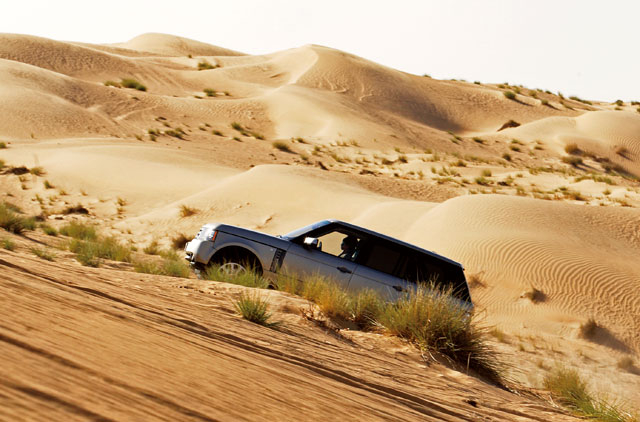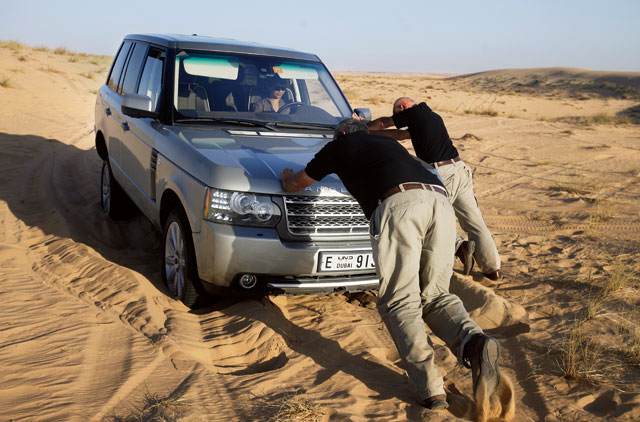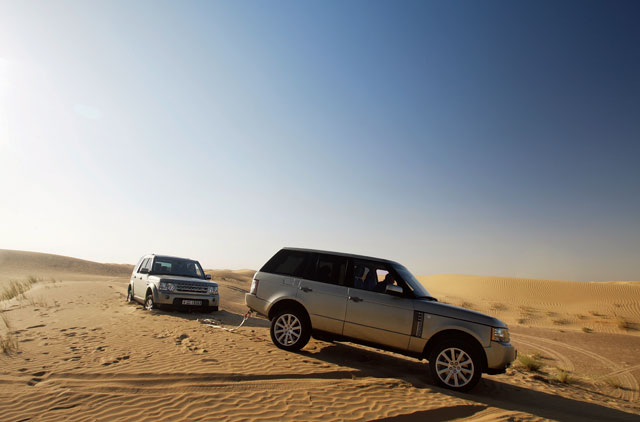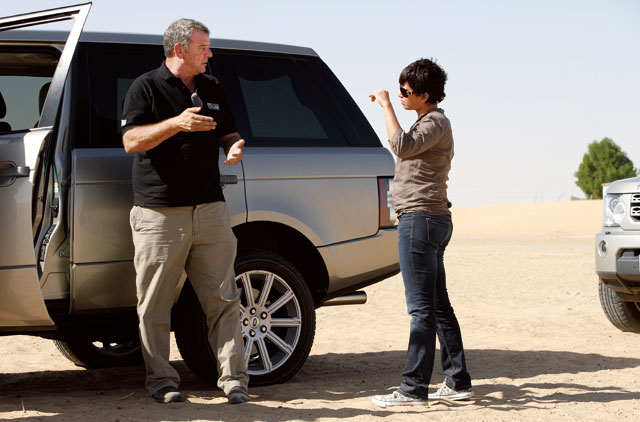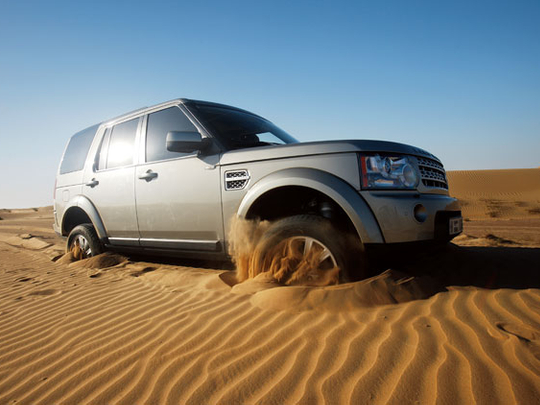
It very easily devolved from a ‘how to' to a ‘how not to' lesson, beginning with how not to get stuck. Which I did. Not once, but three times. For the first two times, I needed tow ropes. For the last, good old pushing.
Now I know that the sepia-hued dunes, just off the Al Ain-Abu Dhabi road, can't really be called the heart of the desert. Yet, for a first-time desert driver like me, even the 15-metre dunes seemed too high and the triangulation points too far.
"Straight line. Approach the dune in a straight line to avoid a rollover," said desert marshal Peter Stuart, a jovial man who has been exploring the desert before navigation systems were as quick as instant coffee. From the passenger seat in the Range Rover HSE, he stared at a dune measuring no more than eight metres. I saw a frightening height never scaled before. I clenched the steering wheel tighter.
The tyres of the 5-litre, V8 had been appropriately deflated, suspension raised, and Terrain Response set to sand driving. According to the marshal's instruction, I had to gauge how much momentum I needed to get to the crest, and no further. He said, "If you go further [than the top], you will be airborne. Vehicles aren't designed to operate midair. As you get to the top, come off the gas. As easy as that."
I tried.
Nothing prepared me for what happened next. Not those risible pictures of a 4WD teetering its underbelly on the apex like a seesaw. Not those survival stories of intrepid desert explorers. Not even Stuart's presence. Because when I stepped on the gas to make my ascend, I looked at the summit with nail-biting nervousness of not knowing what is - or isn't - on the other side. Because unlike driving on tarmac where I read the road and anticipate, the wedge of monolithic sand was all I saw.
Before I could reach the top, I braked. I dug the 19" alloy wheels right in.
"Oh no," I said much in the same tone a five year old throwing a tantrum would.
In an attempt to pull the car and my sliding morale, I stepped on the throttle. I sank in deeper as did my spirits. I cast a glance in Stuart's direction, half expecting him to yell at me. He didn't. His unlined countenance defied my lines of worry and alarm. He took a few seconds to assess, and said, "You have spun the wheels in quite a bit. We can get out, don't worry. Reverse downhill."
"Reverse downhill?" I asked, my face conveying both hesitancy and exasperation.
"You are trying to fight uphill from a stationary position. You have to back up," he said, moving his hands - and my attention - to the centre console of the 4WD where the low range button was located. He shifted the gear to neutral and pressed the button. "It is used in conditions where low speed manoeuvring is needed, especially in extreme off-roading. Right now, we have to get the wheels to move slowly, but with the same power. Keep your wheels straight; you lose power when you turn [the wheels]," he said.
"Is this going to help dislodge us?" I asked.
He nodded.
So I tried.
Back on the flat area (phew), he pointed to the tracks on the dune - the location of my inglorious halt. "You broke the surface of the sand so the wheels had nothing to grip. Desert driving is about flotation, keeping the wheels on the surface for good traction and grip," he said.
Again I stared at the eight-metre dune, primed with the comfort of experience. I played back Stuart's earlier instruction of choosing a straight line, building momentum and getting off the power completely as I get to the top.
I screamed as I drove over the crest, "Woo-hoo! Whoa!"
"That was much better," he said, smiling.
And with those words, I floated on to the next challenge - descend the dune I had just scaled.
"I assume it is easier going down than coming up," I said.
"Yes," he replied. "The weight of the car helps you along."
It seemed easy until I turned the car around and angled the front wheels, nose down, ready for descent. At a 33 degree incline, the slope was unappealing. I lurched forwards at a tilt that ought to be reserved for circus acts. My eye level was uncomfortable. It was then that Stuart said, "Try not to stop the car when you are going down. Remember to work with gravity whenever you can. Just feather or gently tap the brakes to control the car and slow it down. Do not stop. Or use the car's Hill Descent Control (HDC) to do the work for you."
As ashamed as I am to admit that I opted for the easy way out, I took refuge in his logic. He said, "Once you get more confident and familiar with the terrain, do it without the HDC."
"May I use it now?" I asked.
My attention jerked happily away from the declivity and towards the centre console. Stuart switched on the HDC button. The technical support system took over, controlling the vehicle's speed.
I didn't even touch the brake pedal.
In one word: amazing.
And so with me in the driver's seat and Stuart besides me, we followed the support vehicle, the LR4, driven by Fraser Martin, clerk of the course and senior instructor at the Race & Driving School at the Dubai Autodrome. (Another off-roading veteran.)
I bounded up and down, corralling a few of Stuart's comments like "you are getting more used to the car" and "work at a pace that is comfortable" to accelerate my confidence.
At one point, I leaped over the crest and had a rough landing. I asked, "Is that all right?"
He replied, "That is not great. It isn't that you are going to damage the car necessarily, but as soon as your wheel comes off the ground like that, you lose grip. Your traction is gone. Remember, you want your wheels on the ground."
The learning curve turned out to be rather steep.
I learnt off-roading principles, mostly pegged with conditional clauses. If you aren't sure what is over the top, choose another dune. If you trust existing tracks, you might be fooled because the wind moves the sand. If you turn when you are stationary, you risk digging the wheels in. If you drive on a dune that is too steep, you may hit the bumper.
I learnt the don'ts. I shouldn't… position the car or climb on an angle; back up so far that I cannot see where the car is going; drive over the vegetation; turn too tightly (the wider the better); proceed until I check approach and departure angles.
The most enlightening perhaps was that even though there are no enforced rules - lane discipline, radars, speed limits, etc, I had to drive responsibly. At one stage, I realised my fists weren't quivering any more. I was enjoying myself. Sure, I made ham-handed moves corrected by tow ropes and physical pushing. I even drove over a tussock of green and Stuart coined a name for me. Though I was remorseful, he said, "You just killed it. We will call you the bush killer."
Was he being serious?
When we had first started my off-roading training, he traversed the undulations - going up to 20 metres - to demonstrate. After which the lesson continued with me in the driver's seat, and well beyond four hours and into the sunset against herds of Arabian Oryx, deer and gazelle. Earlier, he had mentioned that the learning is different for everybody. "Training people who bring their own cars is very easy because they relate to it [the car]. In your case, you will be learning the car as well as off-roading."
We followed Martin up and down the sinuous curves. Stuart suggested I pick a slightly different line and straddle the tracks to maintain traction. He also said that driving in the desert wasn't about speed. "A lot of people have this idea that you have to go as fast as possible. Not really. If you employ too much power, you will dig the wheels in [the sand]."
He continued, "If you put it down to common sense, it almost covers everything. For starters, you should refrain from going alone and/ or in one vehicle. I've had calls from people who have gotten stuck in the desert at night. As soon as it turns dark, even with a GPS, they lose the track and struggle to get out."
As we got nearer to the Jumeirah Bab Al Shams Desert Resort & Spa (where I stayed for the night, courtesy Land Rover), I realised that the experience with Stuart and Martin, had turned out to be more than just a driving lesson. Somewhere between spotting the Arabian oryx, listening to the gentle susurration of the desert wind, watching the nacreous light turn the dunes from sepia to gold, and basking in the gloaming of the dipping sun, I heard stories born from the desert. Some with disguised metaphors of getting away from the madding crowds. Others undisguised in the way they cautioned mistakes.
For Stuart, off-roading is a profession and hobby. "I see empty places and I want to go there. It is the lure of the unexpected. I don't enjoy race tracks because I know what is coming around [the track] every two minutes. What I love about off-roading is not knowing what is over the next dune." He recalled an incident that took place before mobile phones and navigation systems. "I would use the payphone at the nearest petrol station to let friends know where I was, and camp overnight. The following morning I would call again to say I was OK. One time, I forgot. They automatically thought, ‘Pete hasn't phoned so there must be a problem so let's go'. They had to follow the whole route purely because I was stupid."
Towards the end of my training, I asked, "Was it normal to be a bit nervous?"
"Yes," he replied, adding, "Even the most experienced drivers get stuck."
By the way …
- Apart from the approach and departure angles, you have to worry about the break over point - the area where the underbelly of the car can get stuck.
- Standard off-roading gear should include: first aid kit; safety items (fire extinguisher, etc); personal essentials; recovery equipment (tow ropes, etc)…
- If you go with friends, make sure you have enough seats to get them back safely in case their car gets stuck.
- Before you go off road, ensure you have basic mechanical knowledge of a 4WD. Check the vehicle before you set out.
Carolina D’Souza
cdsouza@gulfnews.com
Twitter: @Carolina_friday


